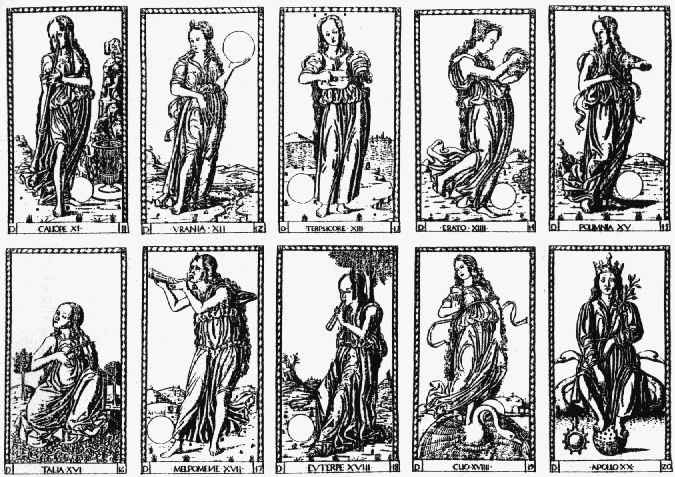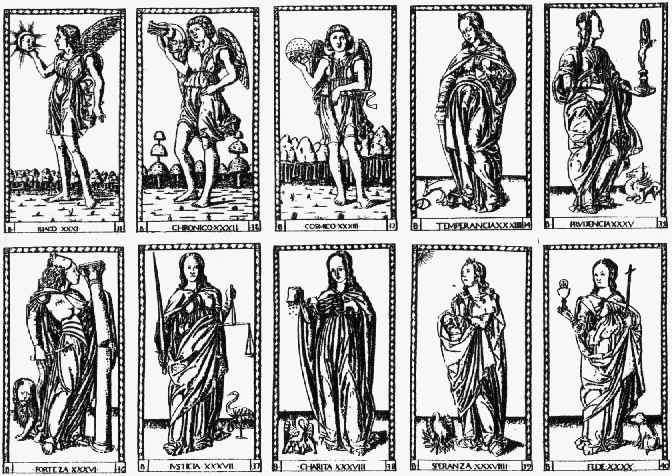|
|
Rafal T. Prinke - Mantegna's Prints in Tarot HistoryArticle originally published in Manteia, 4 (1990), 9.
MANTEGNA'S PRINTS IN TAROT HISTORY The beautiful series of pictorial images known as the Tarocchi di Mantegna is well known to everyone interested in the tarot cards but its place in the early tarot history has not been sufficiently explained so far. These prints (as they survived in uncut sheets only, it is not certain if they were cards at all) contain 50 images divided into 5 groups of 10 pictures each, all in a strictly set order starting with the Beggar, passing through the conditions of man, arts, sciences, virtues and the heavenly spheres crowned with the First Cause. Although some of these pictures strongly resemble some of the standard tarot Major Arcana, the whole series is obviously quite different.
 In spite of the traditional name of this set, all the modern writers state that the engravings are not the work of Andrea Mantegna (1432-1506). Nobody, however, seems to have noticed the short fragment on Mantegna in the best source on Renaissance Italian artists - Giorgio Vasari's Lifes of Artists - where it is clearly stated that he made copper engravings of trionfi which "were considered to be perfect, as no better ones were known". In the original Italian the sentence reads: "Si diletto il medesimo, siccome fece il Pollajuolo, di fare stampe di rame, e fra l'altre cose fece i suoi trionfi, e ne fu allora tenuto conto, perche non si era veduto meglio" (Giorgio Vasari, Vite de' piu' eccellenti pittori, scultori e architetti, Milano, 1809, vol. 6, p. 218). This short quotation is of utmost importance for tarot history. It proves that Mantegna was indeed the author of the engravings attributed to him (which are dated to circa 1460) and, what is even more important, that the term trionfi was not reserved for the standard tarot deck only but was a generic name for a certain type of cards including those of Mantegna (Michael Dummet in The Game of Tarot p. 82 and 83 says there are no such proofs).
 Mantegna worked for Isabella d'Este of Ferrara who was closely connected with the earliest references to the tarot (trionfi) cards, and even painted two "trionfi" pictures for her: Parnas or the triumph of love and The triumph of virtue. It is now generally accepted that both early tarot decks and various other "triumph" themes in the early Renaissance Italian art have their common source in triumphal parades of the period and in Petrarch's influencial poem I trionphi. The basic idea of these was a sequence of images or personifications, each of which "triumphed" over the preceding one, and the same scheme can be observed in the Mantegna series. Another hypothesis connects the tarot images with the hermetic art of memory but it has been overlooked that both of these theories converge in the person of Petrarch who was regarded as the father of that art. It seems, therefore, that it was Petrarch's idea to use the images of triumphal parade as vehicles for the art of memory images, while some later artist used the same idea for visual images of the earliest trionfi cards.
 The earliest known tarot deck is that of Visconti di Modrone, also known as Cary/Yale deck, usually dated to circa 1440, though some authors place it even in 1428. It is very different from the later standard deck and contains not only one more court figure but also at least three additional Major Arcana cards - the theological virtues of Faith, Hope and Charity. There are also descriptions of two other decks of similar "triumphal" character, though much more different from the standard tarot, all made for the same person - Filippo Maria Visconti. One was by Michelino da Besozzo and the other is attributed to Marziano da Tortona. It seems, therefore, that around 1440 at the courts of Milan and Ferrara there was a fashion for cards with mythological and alegorical images which were used for playing but at the same time were imbued with deep hermetic symbolism intended for practising the magical art of memory.
 It is interesting to compare the structure of Mantegna's cards with that of the "memory theatre" of Camillo (as described by Frances Yates in her Art of Memory) to see the striking similarity. Both are condensed symbolic representations of the hermetic universe and also the magical tools with which one could rule the universe applying the occult art of memory as developed by the Renaissance magi. Although the structure of the standard tarot Major Arcana series is not as clear as that of Mantegna's prints, it is similar enough to state that the function of the tarot must have been the same. Of course this does not explain why the later standard of the Major Arcana won popularity nor what its structure really shows but at least it clarifies some of the issues of the early developement of the tarot cards which can now be represented like this:
|